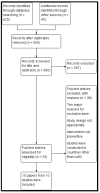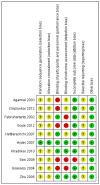Effects of Preventive Nutrition Interventions among Adolescents on Health and Nutritional Status in Low- and Middle-Income Countries: A Systematic Review and Meta-Analysis
- PMID: 31878019
- PMCID: PMC7019616
- DOI: 10.3390/nu12010049
Effects of Preventive Nutrition Interventions among Adolescents on Health and Nutritional Status in Low- and Middle-Income Countries: A Systematic Review and Meta-Analysis
Abstract
The objective of this review was to assess the impact of preventive nutrition interventions on health and nutritional status of adolescents aged 10-19 years in low- and middle-income countries (LMICs). We searched the databases until 5 February 2019 without any restrictions on publication, date, language, or publication status. A total of 10 studies (15 papers) including 10,802 participants assessing the impact of micronutrient supplementation/fortification were included in this review. We did not find any study assessing the impact of nutrition education and counseling or macronutrient supplementation among adolescents. Among primary outcomes, we are uncertain of the effect of iron supplementation with or without folic acid on anemia (daily supplementation; relative risk (RR): 1.04, 95% confidence interval (CI) 0.42, 2.57; one study; 1160 participants; low-quality evidence; weekly supplementation; RR: 1.07, 95% CI: 0.46, 2.52; one study; 1247 participants; low-quality evidence). We are also uncertain of the effect of various micronutrient supplementation/fortification on body mass index (BMI) (calcium/vitamin D supplementation; (MD: -0.01 kg/m2; 95% CI: -1.20, 1.17; two studies; 730 participants; I2 94%; very-low-quality evidence, iron supplementation with or without folic acid; MD: 0.47 kg/m2; 95% CI: -0.17, 1.11; two studies; 652 participants; I2 37%; very-low-quality evidence, zinc supplementation; MD: 0.35 kg/m2; 95% CI: -0.15, 0.85; one study; 382 participants; very-low-quality evidence) and multiple micronutrient (MMN) fortification; MD: 0.23 kg/m2, 95% CI: -0.11, 0.57; two studies; 943 participants; I2 22%; very-low-quality evidence). None of the included studies reported any other primary outcomes including morbidity or adverse effects. Among secondary outcomes, iron supplementation with or without folic acid may improve hemoglobin concentrations, and calcium/vitamin D supplementation may improve serum 25(OH)D levels, while calcium only supplementation and calcium and vitamin D supplementation may marginally improve total body bone mineral density (BMD). We are uncertain of the effect of MMN fortification on hemoglobin concentrations, calcium supplementation on total body bone mineral content (BMC), calcium + vitamin D supplementation on total body BMC, and zinc supplementation on zinc levels. There is limited evidence of micronutrient supplementation/fortification among adolescents, especially adolescent boys, on health and nutritional status in LMICs. These findings should be interpreted with caution due to the low quality and limited number of studies.
Keywords: adolescent health; nutrition; nutrition interventions.
Conflict of interest statement
The authors declare no conflict of interest.
Figures





References
-
- World Health Organization . Health for the World’s Adolescents: A Second Chance in the Second Decade: Summary. World Health Organization; Geneva, Switzerland: 2014.
-
- Reiner R.C., Olsen H.E., Ikeda C.T., Echko M.M., Ballestreros K.E., Manguerra H., Martopullo I., Millear A., Shields C., Smith A. Diseases, injuries, and risk factors in child and adolescent health, 1990 to 2017: findings from the Global Burden of Diseases, Injuries, and Risk Factors 2017 Study. JAMA Pediatrics. 2019;173:e190337. - PMC - PubMed
Publication types
MeSH terms
Substances
Grants and funding
LinkOut - more resources
Full Text Sources
Medical

